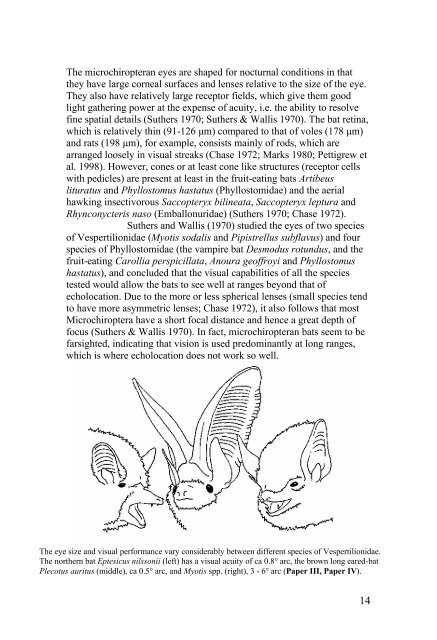Vision in echolocating bats - Fladdermus.net
Vision in echolocating bats - Fladdermus.net
Vision in echolocating bats - Fladdermus.net
You also want an ePaper? Increase the reach of your titles
YUMPU automatically turns print PDFs into web optimized ePapers that Google loves.
The microchiropteran eyes are shaped for nocturnal conditions <strong>in</strong> that<br />
they have large corneal surfaces and lenses relative to the size of the eye.<br />
They also have relatively large receptor fields, which give them good<br />
light gather<strong>in</strong>g power at the expense of acuity, i.e. the ability to resolve<br />
f<strong>in</strong>e spatial details (Suthers 1970; Suthers & Wallis 1970). The bat ret<strong>in</strong>a,<br />
which is relatively th<strong>in</strong> (91-126 µm) compared to that of voles (178 µm)<br />
and rats (198 µm), for example, consists ma<strong>in</strong>ly of rods, which are<br />
arranged loosely <strong>in</strong> visual streaks (Chase 1972; Marks 1980; Pettigrew et<br />
al. 1998). However, cones or at least cone like structures (receptor cells<br />
with pedicles) are present at least <strong>in</strong> the fruit-eat<strong>in</strong>g <strong>bats</strong> Artibeus<br />
lituratus and Phyllostomus hastatus (Phyllostomidae) and the aerial<br />
hawk<strong>in</strong>g <strong>in</strong>sectivorous Saccopteryx bil<strong>in</strong>eata, Saccopteryx leptura and<br />
Rhynconycteris naso (Emballonuridae) (Suthers 1970; Chase 1972).<br />
Suthers and Wallis (1970) studied the eyes of two species<br />
of Vespertilionidae (Myotis sodalis and Pipistrellus subflavus) and four<br />
species of Phyllostomidae (the vampire bat Desmodus rotundus, and the<br />
fruit-eat<strong>in</strong>g Carollia perspicillata, Anoura geoffroyi and Phyllostomus<br />
hastatus), and concluded that the visual capabilities of all the species<br />
tested would allow the <strong>bats</strong> to see well at ranges beyond that of<br />
echolocation. Due to the more or less spherical lenses (small species tend<br />
to have more asymmetric lenses; Chase 1972), it also follows that most<br />
Microchiroptera have a short focal distance and hence a great depth of<br />
focus (Suthers & Wallis 1970). In fact, microchiropteran <strong>bats</strong> seem to be<br />
farsighted, <strong>in</strong>dicat<strong>in</strong>g that vision is used predom<strong>in</strong>antly at long ranges,<br />
which is where echolocation does not work so well.<br />
The eye size and visual performance vary considerably between different species of Vespertilionidae.<br />
The northern bat Eptesicus nilssonii (left) has a visual acuity of ca 0.8° arc, the brown long eared-bat<br />
Plecotus auritus (middle), ca 0.5° arc, and Myotis spp. (right), 3 - 6° arc (Paper III, Paper IV).<br />
14


